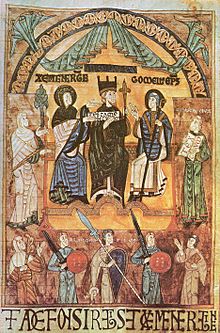Alfonso III of Asturias
You can help expand this article with text translated from the corresponding article in Spanish. (June 2012) Click [show] for important translation instructions.
|
| Alfonso III | |
|---|---|
 Miniature from the archives of Oviedo Cathedral showing Alfonso III flanked by his queen, Jimena (left), and his bishop, Gomelo II (right). | |
| King of Asturias | |
| Reign | 866–910 |
| Predecessor | Ordoño I |
| Successor | Fruela II (Asturias) García I (León) Ordoño II (Galicia) |
| Born | c. 848 |
| Died | December 910 |
| Burial | |
| Consort | Jimena of Pamplona |
| Issue | Fruela II of León García I of León Ordoño II of León |
| Dynasty | Beni Alfons |
| Father | Ordoño I of Asturias |
| Mother | Nuña |
| Religion | Roman Catholicism |
| Signature |  |
Alfonso III (c. 848 – December 910), called the Great, was the king of León, Galicia and Asturias from 866 until his death. He was the son and successor of Ordoño I. In later sources he is the earliest to be called "Emperor of Spain." He was also titled "Prince of all Galicia" (Princeps totius Galletiae[1]).
Life
Little is known about Alfonso except the bare facts of his reign and of his comparative success in consolidating the kingdom during the weakness of the Umayyad princes of Córdoba. He fought against and gained numerous victories over the Muslims of al-Andalus.
He defeated a Basque rebellion in 867 and, much later, a Galician one as well. He conquered Oporto and Coimbra in 868 and 878 respectively. In about 869, he formed an alliance with the Kingdom of Pamplona, and solidified this link by marrying Jimena, who is thought to have been daughter of king García Íñiguez, or less likely, a member of the Jiménez dynasty, and also married his sister Leodegundia to a prince of Pamplona.
He ordered the creation of three chronicles which presented the theory that the kingdom of Asturias was the rightful successor of the old Visigothic kingdom. He was also a patron of the arts, like his grandfather before him. He built the church of Santo Adriano de Tuñón. According to a letter of disputed authenticity dated to 906, the Epistola Adefonsi Hispaniae regis, Alfonso arranged to purchase an "imperial crown" from the cathedral of Tours.[2]
A year before his death, three of Alfonso's sons rose in rebellion and forced him to abdicate, partitioning the kingdom among them. The eldest son, García, became king of León. The second son, Ordoño, reigned in Galicia, while the third, Fruela, received Asturias with Oviedo as his capital. Alfonso died in Zamora, probably in 910. His former realm would be reunited when first García died childless and León passed to Ordoño. He in turn died when his children were too young to ascend, Fruela became king of a reunited crown. His death the next year initiated a series of internecine struggles that led to unstable succession for over a century.
References
- ^ España Sagrada. Memorias de los insignes monasterios de San Julián de Samos, y San Vicente de Monforte.
- ^ R. A. Fletcher, Saint James's Catapult: The Life and Times of Diego Gelmírez of Santiago de Compostela (Oxford, 1984), 317–23.
Sources
- Chisholm, Hugh, ed. (1911). . Encyclopædia Britannica. Vol. 1 (11th ed.). Cambridge University Press.
